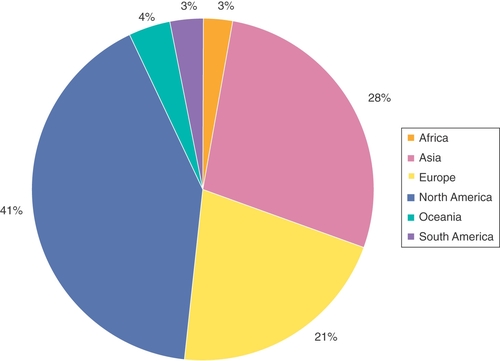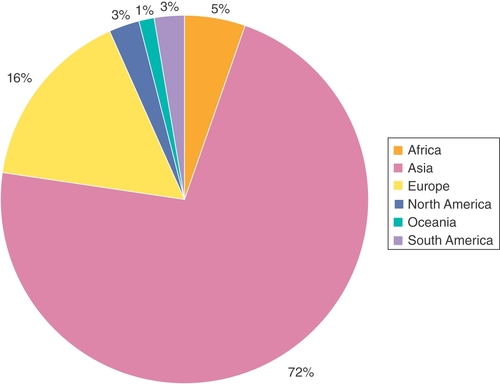I’m once again delighted to welcome you to the 19th Volume of Future Virology!
As is tradition, this issue will begin with some of the content highlights from last year. First, though, I’d like to take the opportunity to thank all our readers, authors and reviewers on behalf of the Future Virology team for their continued support and engagement with the journal. Last year, we were incredibly excited about the increase in the journal’s impact factor to 3.1 (2022). We look forward to continuing to work together to grow the journal’s impact in the upcoming year and bring you even more excellent content!
Content highlights
While the public health emergency for COVID-19 might have been officially declared over, many of the top-read () and top-cited () articles from Volume 18 continued to explore the fallout of the COVID-19 pandemic.
Table 1. Top articles in Volume 18 of Future Virology by downloadsTable Footnote†.
Table 2. Top articles in Volume 18 of Future Virology by citationsTable Footnote†.
The most-read article of Volume 18 was ’A twisting tale of misinformation: should ivermectin be approved as a treatment for COVID-19 disease?’ by Shafiee, Teymouri Athar and Mozhgani [Citation1]. This Editorial examined why the evidence around the use of ivermectin, a US FDA-approved treatment for parasitic infections, has become so controversial in the treatment or prevention of COVID-19. The authors note that “the current body of evidence for ivermectin has been seriously undermined by a lack of good-quality evidence and… misleading information on social media”, highlighting that “there has been a considerable promotion in the off-label use of ivermectin as a result of misperceptions caused by ’fake news’… lacking any supporting data” [Citation1]. Given the significant public interest in ivermectin, it is perhaps no surprise that this Editorial attracted considerable attention on X (formerly Twitter) and from various news outlets; the article’s high attention score even ranked within the top five highest-scoring articles from Future Virology, as measured by Altmetric [Citation7].
Accurate testing has been a cornerstone of global efforts to control the COVID-19 pandemic, but the possibility of obtaining false-positive or false-negative results has sustained interest in the diagnosis of COVID-19. In this regard, the second most-read article of the volume aimed to establish whether testing for the presence of a third target gene, the E gene, improves the specificity of diagnostic tests [Citation2]. This paper from Barjaktarović et al. proposed that the high stability of the E gene reduces the likelihood of false-negative results of infections with new variants, which is particularly relevant in light of the continuous emergence of new variants of interest or concern, such as BA.2.86.
In addition to treatment and diagnosis, one aspect of COVID-19 that has continued to receive attention from both the public and scientific community is vaccination and its possible consequences. While most adverse reactions to the COVID-19 vaccines are mild, Mannan Baig et al. discussed the incidence of serious neurological consequences in the third most-read article of the volume, ’COVID-19 post vaccination neuronal adverse events: probable mechanisms and treatment possibilities’ [Citation3]. In this Editorial, the authors stated that the incidence of neurological adverse effects following a COVID-19 vaccine is reportedly higher than vaccines for other viral infections and that these responses are “concerning as their incidence continues to be difficult to quantify, and their underlying cause remains uncertain” [Citation3]. The authors went on to propose potential mechanisms, including differential immune responses and the escape of vaccine components into the nervous system, and potential anti-neuroinflammatory treatments.
The highly cited articles from Volume 18 further illustrated current trends in COVID-19 research, namely novel antiviral treatments, such as drug repurposing and immunomodulation, and vaccine hesitancy. Nag et al., for example, provided a comprehensive review of the potential for DPP-4 inhibitors (typically an antidiabetic treatment) to be repurposed to treat COVID-19 [Citation4], while Zafarani et al. expertly summarized the effects of SARS-CoV-2 infection and vaccination on natural killer (NK) cells and the use of NK-based and NK-targeting therapies [Citation5]. Both sets of authors highlighted the importance of identifying novel therapies for populations at high risk of mortality, including the immunodeficient and diabetic. Chirico and Teixeira de Silva, on the other hand, provided a thoughtful perspective on the issue of misinformation in vaccine hesitancy and the importance of education, effective messaging and an open data policy in tackling this [Citation6].
Plain language summaries
In addition to our research, review and opinion content, Future Virology saw fantastic engagement with our Plain Language Summary of Publications (PLSPs) last year. PLSPs are an increasingly popular publication type that present scientific research in a plain-language, visually enriched format and aims to connect our content to a wider nonspecialist audience, including patients and the public. If you’re interested in learning more about PLSPs, please visit https://www.plainlanguagesummaries.com/ [Citation8].
Our most popular PLSPs last year, summarized in , reiterated the considerable public interest in understanding the safety and effectiveness of COVID-19 vaccination. The first, from Frenck et al. on behalf of the C4591001 Clinical Trial Group, summarized the main results of a clinical trial of the Pfizer-BioNTech vaccine in 12–15-year-olds [Citation9]. Similarly, Creech et al. provided a concise and digestible summary of the latest results from the KidCOVE study of the Moderna mRNA-1273 vaccine in children 6–11 years old [Citation10]. Both summaries improved the accessibility of complex vaccine data, a critical factor in the informed decision-making of the public and healthcare professionals and in tackling vaccine hesitancy.
Table 3. Top Plain Language Summaries in Volume 18 of Future Virology by downloadsTable Footnote†.
Demographics
Future Virology’s readership and authorship demographics remained relatively consistent since the previous year ( & ) [Citation11]. The journal saw a small increase in our readership in Asia, Europe and South America last year, as well as an increase in content from Asia, Europe and Oceania. Submissions and access requests were received from a considerable number of new regions including Nepal, Estonia, Italy, Australia, Montenegro, Rwanda and Sierra Leone, respectively. It is incredibly rewarding to see the expansion of the journal’s reach even 17 years after its launch, and we look forward to continuing to grow the journal’s authorship and readership over the next 12 months.
Editorial board & special focus issues
Last year, Future Virology saw a considerable change in the Editorial Board and we look forward to welcoming a new generation of researchers to provide their invaluable expertise, support and guidance to the journal, alongside our experienced members. We would like to extend our utmost thanks to the Editorial Board for their steadfast commitment to the journal.
While no Special Focus Issues were published in Future Virology last year, I’d like to take this opportunity to remind our readers that the journal welcomes unsolicited Special Focus Issue proposals. More information and a proposal form can be found here: Special Focus Issues (tandfonline.com) [Citation12].
I’d like to conclude this Foreword by reminding our readers that they can keep up to date with the latest journal content by following our X account, @fsgfvl [Citation13], and that Future Virology strongly encourages unsolicited submissions and pre-submission inquiries. For more information about our article types and submission, please visit our website, https://www.tandfonline.com/loi/fvl [Citation14].
Financial disclosure
The author is an employee of Future Science Group. The author has no other relevant affiliations or financial involvement with any organization or entity with a financial interest in or financial conflict with the subject matter or materials discussed in the manuscript apart from those disclosed.
Competing interests disclosure
The author is an employee of Future Science Group. The author has no other competing interests or relevant affiliations with any organization or entity with the subject matter or materials discussed in the manuscript apart from those disclosed.
Writing disclosure
No writing assistance was utilized in the production of this manuscript.
References
- Shafiee A , TeymouriAthar MM , MozhganiSH. A twisting tale of misinformation: should ivermectin be approved as a treatment for COVID-19 disease?Fut. Virol.18(3), 137–139 (2023).
- Barjaktarović I , StojčevićMaletić J , VučinićN , MilutinovićA , GrujičićM , ČabarkapaV. Diagnosing COVID-19: diagnostic importance of detecting E gene of the SARS-CoV-2 genome. Fut. Virol.18(1), 31–38 (2023).
- Baig AM , GerlachJ , SalunkeP , JesseyR , RoseR. COVID-19 post vaccination neuronal adverse events: probable mechanisms and treatment possibilities. Fut. Virol.18(7), 399–401 (2023).
- Nag S , MandalS , MukherjeeO , MukherjeeS , KunduR. DPP-4 inhibitors as a savior for COVID-19 patients with diabetes. Fut. Virol.18(5), 321–333 (2023).
- Zafarani A , RazizadehMR , PashangzadehS , AmirzargarMR , Taghavi-FarahabadiM , MahmoudiM. Natural killer cells in COVID-19: from infection, to vaccination and therapy. Fut. Virol.18(3), 177–191 (2023).
- Chirico F , Teixeirade Silva JA. Evidence-based policies in public health to address COVID-19 vaccine hesitancy. Fut. Virol.18(4), 261–273 (2023).
- Altmetric . https://www.altmetric.com/
- Future Science Group . Plain Language Summaries. https://www.plainlanguagesummaries.com/
- Frenck RW , KleinNP , KitchinNet al. ;for the C4591001 Clinical Trial Group. Plain language summary of Pfizer-BioNTech BNT162b2 vaccine protection against COVID-19 and its safety in participants 12- to 15-years old. Fut. Virol.18(1), 9–20 (2023).
- Creech CB , AndersonE , BerthaudVet al. ; for the KidCOVE Study Group. Plain language summary of a clinical trial evaluating mRNA-1273, Moderna’s mRNA-Based COVID-19 vaccine, in children 6 through 11 years of age. Fut. Virol.18(10), 615–620 (2023).
- Porter E . Let’s make this go viral: welcome to your 18th dose of Future Virology. Fut. Virol.18(1), 1–4 (2023).
- Future Medicine . Special Focus Issues. https://www.tandfonline.com/special-issues#:∼:text=Future%20Science%20Group%20journals%20welcome,the%20scope%20of%20the%20journal
- X. Future Virology . https://twitter.com/fsgfvl
- Future Medicine . Future Virology. https://www.tandfonline.com/journal/fvl


